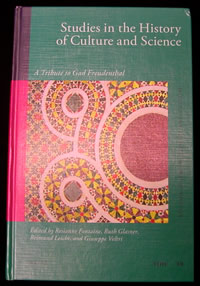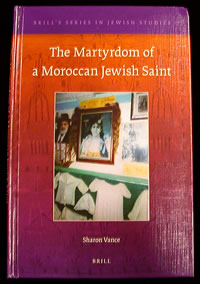I just initialed a purchase requisition for 14 books – not an uncommon act of an academic library’s director. The price tag: $3032.00 – less and less an uncommon price tag for scholarly publications. Why should you care? Because as I was excitedly reading the back-cover summaries and endorsements, pouring over their rich tables of content, and congratulating myself on once again putting our collection on the cutting edge of scholarship, it dawned on me that it may take a long time before anyone else gets excited over any of them, or over the total amounts that our library system invests in anticipating and meeting the needs of our faculty and students.
Why is that? I asked myself, and what can the library do to make you more aware, and to make the books more visible? But before I answer my own questions (not a Hokhmeh*, as my mother would say…), I am going to have you taste the titles, breath in the aromas of intriguing ideas, and hopefully, have you order from the menu:

Studies in the History of Culture and Science: a Tribute to Gad Freudenthal. Edited by R. Fontaine, R. Glasner, R. Leicht and G. Veltri. Twenty two chapters on the history of science and the role of science in Judaism.
From Two Kingdoms to One Nation – Israel and Judah; Studies in Division and Unification. By Shamai Gelander.
Bene Israel: Studies in the Archaeology of Israel and the Levant during the Bronze and Iron Ages in Honour of Israel Finkelstein. Edited by A. Fantalkin & A. Yasur-Landau.
“From a Sacred Source”: Genizah Studies in Honour of Professor Stefan C. Reif. Edited by B.M. Outhwaite & S. Bhayro. Papers from the 2007 Cambridge conference
Spirituality in the Writings of Etty Hillesum: Proceedings of the Etty Hillesum Conference at Ghent University, November 2008. Edited by K.A.D. Smelik, R. van den Brandt & M.G.S. Coetsier.
The Same but Different? : Inter-Cultural Trade and the Sephardim, 1595-1640. By J. V. Roitman. The study challenges historiographical arguments that the Sephardim achieved their commercial success by relying on geographically dispersed family members and fellow ethnics.
Opening the Gates of Interpretation: Maimonides’ Biblical Hermeneutics in Light of His Geonic-Andalusian Heritage and Muslim Milieu. By M.Z. Cohen.
 The Temple of Jerusalem: From Moses to the Messiah, in Honor of Professor Louis H. Feldman. Edited by Steven Fine.
The Temple of Jerusalem: From Moses to the Messiah, in Honor of Professor Louis H. Feldman. Edited by Steven Fine.
Legal Fictions: Studies in Law and Narrative in the Discursive Worlds of Ancient Jewish Sectarians and Sages. By S. D. Fraade
From Conquest to Coexistence: Ideology and Antiquarian Intent in the Historiography of Israel’s Settlement in Canaan. By K. van Kekkum.
Without Any Doubt: Geronides on Method and Knowledge. By S. Klein-Braslavy.
 The Martyrdom of a Moroccan Jewish Saint. By S. Vance On the martyrdom of Sol Hatchuel, a Jewish girl from Tangier, that traumatized the Jewish community and inspired a literary response in Morocco and beyond.
The Martyrdom of a Moroccan Jewish Saint. By S. Vance On the martyrdom of Sol Hatchuel, a Jewish girl from Tangier, that traumatized the Jewish community and inspired a literary response in Morocco and beyond.
The City Besieged: Siege and Its Manifestations in the Ancient Near East. By I. Eph’al.
History of Modern Jewish Religious Philosophy; v. 1: The Period of the Enlightenment. By Eliezer Schweid.
ARE YOU STILL READING THIS BLOG? WHY AREN’T YOU IMPATIENTLY TAPPING YOUR FINGERS ON THE CIRCULATION DESK SO WE CAN HURRY UP AND CHECK ANY OR ALL OF THESE BOOKS TO YOU?
 Aha! Time to Jewishly answer my original questions – that is, with more questions – and make a few suggestions that will make such treasures more visible and accessible to you.
Aha! Time to Jewishly answer my original questions – that is, with more questions – and make a few suggestions that will make such treasures more visible and accessible to you.
Did you know you can find out about our recent acquisitions when you log on to our website? Try: http://blog.huc.edu/aquisitions/LA/
Do you ever look at the bookstand at the entrance to our Joseph Reading Room? This serves as the “hot off the press” carousel to books that are even newer than the ones listed on the “New Books” page!
How about looking at the dust jackets’ displayed on our bulletin board? (Librarian lingo for book covers…) Everything up there is catalogued, shelved, and ready to go!
OK. Now it’s up to you to make me a true believer, allow me to complete the purchase request with a clean conscience and consider it money well spent.
Enjoy!
Yaffa
* Profound wisdom, in (sarcastic) Yiddish







 לכתוב בשפת האחר: מבטים על ספרות עברית וערבית. רסלינג 2010
לכתוב בשפת האחר: מבטים על ספרות עברית וערבית. רסלינג 2010
 In addition to the fact that he was a professor of Political Science in the UC system, I was told by Ms. Sturgess that his father was a rabbi in Santa Monica, having moved there in the early 50s from Toronto, Canada. My initial research revealed a family saga fit to be “treated” and produced as a mini-series in this tinsel-town of ours: a young immigrant from Lithuania, Samuel Sachs, arriving in New York at the beginning of the 20th century, possibly with his parents, with a good probability that the father, Yehudah, was a rabbi in Lithuania. Samuel is ordained by JTS in 1916, and after receiving his B.A. from Columbia University, he is invited in 1926 by congregation Goel Tzedek in Toronto to serve as their rabbi. Somewhere on this time-line he marries Florence [later “find” her cookbook and recipes], and they have two children. One of them, Elliot-Elijah, is born in 1933 [later “find”: Bar Mitzva Book of the Jewish National Fund, 1946]. After twenty years of service and social justice activism [later “find”: hundreds of pamphlets on issues of Labor relations, Zionism, Pioneers in the Land of Israel, Antisemitism, Communism, Socialism, Nazism, Jewish Philanthropy], they move to Santa Monica where Rabbi Sachs serves as the rabbi of Mishkan Tefilah (1952-1964). Elliot studies Political Science and begins teaching in the UC system… and by now I am hooked…
In addition to the fact that he was a professor of Political Science in the UC system, I was told by Ms. Sturgess that his father was a rabbi in Santa Monica, having moved there in the early 50s from Toronto, Canada. My initial research revealed a family saga fit to be “treated” and produced as a mini-series in this tinsel-town of ours: a young immigrant from Lithuania, Samuel Sachs, arriving in New York at the beginning of the 20th century, possibly with his parents, with a good probability that the father, Yehudah, was a rabbi in Lithuania. Samuel is ordained by JTS in 1916, and after receiving his B.A. from Columbia University, he is invited in 1926 by congregation Goel Tzedek in Toronto to serve as their rabbi. Somewhere on this time-line he marries Florence [later “find” her cookbook and recipes], and they have two children. One of them, Elliot-Elijah, is born in 1933 [later “find”: Bar Mitzva Book of the Jewish National Fund, 1946]. After twenty years of service and social justice activism [later “find”: hundreds of pamphlets on issues of Labor relations, Zionism, Pioneers in the Land of Israel, Antisemitism, Communism, Socialism, Nazism, Jewish Philanthropy], they move to Santa Monica where Rabbi Sachs serves as the rabbi of Mishkan Tefilah (1952-1964). Elliot studies Political Science and begins teaching in the UC system… and by now I am hooked… One week later I am standing in the middle of a townhouse in Santa Barbara that is empty, except for book shelves everywhere; entrance, hallway, kitchen, bedrooms, and a whole second floor that is designated as a library. Wall to wall book cases, hundreds of books meticulously protected by wrapped dust jackets, and in the middle of the room – about a hundred boxes ready to go. I ask for permission, and once given, I start pulling out books at random. I glimpse title pages of books dating back to the 1920 & 1930s from Great Britain, European imprints of early Christianity scholarship, an occasional commentary in Hebrew, published in Europe in the 19th century. The “kid in the candy store” feeling intensifies…Ms. Sturgess mentions a guesthouse in the front. I open the door and the studio apartment is filled with more boxes…I’m sold!
One week later I am standing in the middle of a townhouse in Santa Barbara that is empty, except for book shelves everywhere; entrance, hallway, kitchen, bedrooms, and a whole second floor that is designated as a library. Wall to wall book cases, hundreds of books meticulously protected by wrapped dust jackets, and in the middle of the room – about a hundred boxes ready to go. I ask for permission, and once given, I start pulling out books at random. I glimpse title pages of books dating back to the 1920 & 1930s from Great Britain, European imprints of early Christianity scholarship, an occasional commentary in Hebrew, published in Europe in the 19th century. The “kid in the candy store” feeling intensifies…Ms. Sturgess mentions a guesthouse in the front. I open the door and the studio apartment is filled with more boxes…I’m sold! There is really no defined or planned “ending” to this story. I have 400 more boxes of books to unpack and more to learn about the Sachs family. The Library staff is busy cataloging, processing and conserving these new additions to our collection. We are planning an event that will recognize the Sachs gift and the people that helped to bring it about during the upcoming Jewish Book Month, so stay tuned.
There is really no defined or planned “ending” to this story. I have 400 more boxes of books to unpack and more to learn about the Sachs family. The Library staff is busy cataloging, processing and conserving these new additions to our collection. We are planning an event that will recognize the Sachs gift and the people that helped to bring it about during the upcoming Jewish Book Month, so stay tuned.